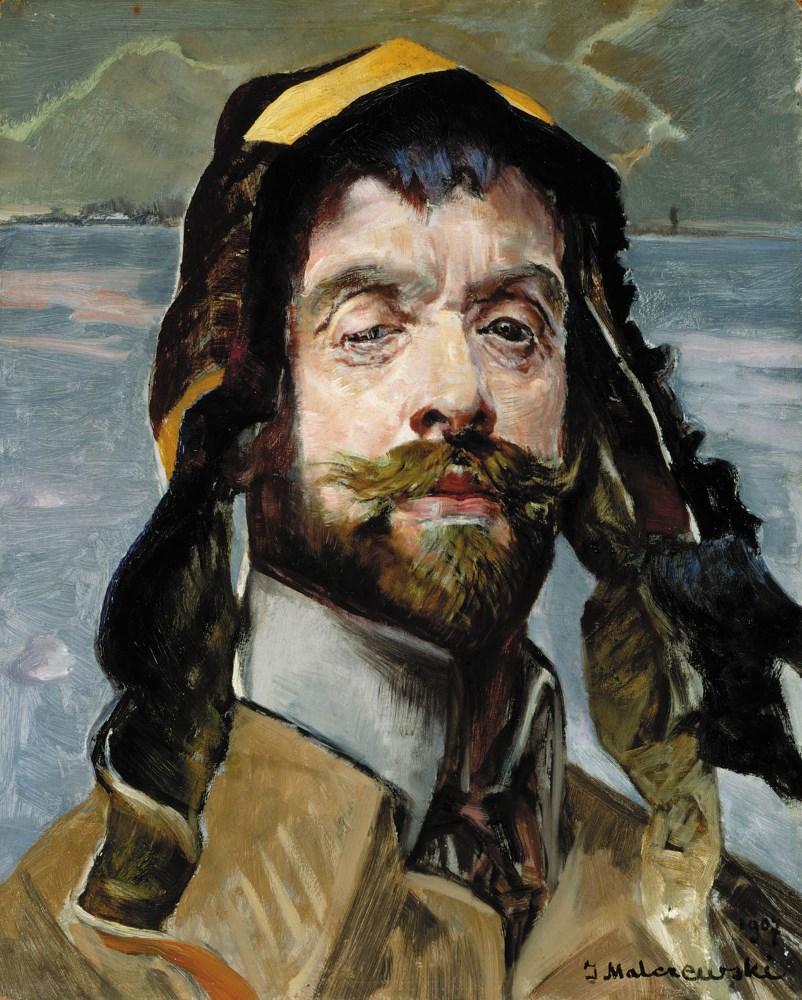Description:
Jack Malczewski (1854-1929) had a deep love for art, literature, and romantic poetry, specifically the poetry of Juliusz Slowacki, which he acquired from his family home. He came from a szlachta-check family, though not a wealthy one. His father, Julian, supported his career in painting. The events of 1863, the January Uprising and subsequent repression, left a deep impression on the young artist. His first teacher was Adolf Dygasinski. He spent his youth from 1867-1871 in the Karczewski family mansion in Wielgie. In 1873 he began studying at the Academy of Fine Arts in Krakow under the supervision of Jan Matejko. He was a student of Władysław Łuszczkiewicz. He also trained at the École des Beaux-Arts in Paris. He traveled to Italy, Vienna, Munich, Greece, and Asia Minor. From 1896-1900 and 1910-1914 he was a professor at the Academy of Fine Arts in Krakow. From 1912-1914 he was its rector. He started with an idealized realism, then naturalism, with the main theme of his works in this period being the fate of exiles in Siberia and the inspiration of Juliusz Slowacki’s “Anhellim”. At the same time, fantastic and allegorical representations began to appear in Malczewski’s work. After his father’s death in 1884, the recurring motif in Malczewski’s work was Thanatos – the god of death. After 1890, his art became completely symbolic. Works manifesting the turn towards a symbolist style are “Introduction” 1890, “Melancholy” 1890-1894, and “Vicious Circle” 1895-1897. The artist addressed existential, historical, and artistic topics, interweaving classical and biblical motifs with native folklore and the Polish landscape, so important in his works. Form, color, the monumentality of the representations, and their expression became his trademark.
Description of the painting:
“Self-Portrait in a Yakut Hat” is an artistic manifestation of Jacek Malczewski. This time the painter transports us to the region of the Siberian Yakut. The hat appearing on the painting is often worn by the female characters painted by the artist, such as Ellenai, the companion of Anhelles from Juliusz Słowacki’s poem. The self-portrait serves as a counter to the criticism made of Malczewski for constantly returning to the same themes, including those taken from the works of the poet. The painter dons a distinctive element of clothing associated with literary characters, thus showing that the artistic path he has chosen, the presented contents and characters will remain unchanged, as they are proper and necessary.
The bust of Jacek Malczewski was depicted against the vast expanse covered with a layer of snow and frozen over. Above the horizon line, dark clouds cross the sky with bright lightning streaks. The fifty-year-old painter stands proudly upright. His raised head is adorned with a Cossack hat. All the anatomical details of the artist’s face, which are a testimony to the inexorably passing time, were realistically rendered. The drooping eyelid covered his right eye. Malczewski’s gaze is directed to the left. This intensifies the impression of him taking on an artificial, almost demonstrative pose of a model. He is dressed in a shirt and a szynel, a Siberian coat. “The szynel falling from the artist’s shoulders in the studio, or the shackles on his hands or legs, the thick coat that does not match the other parts of the wardrobe of the portrayed coat – they lead to subordination, oppression, degradation, they are signs of double, often contradictory meanings. Between them, the creator seems to be looking for a way of expressing sincerity through continuous reflection, seeking the meaning of the way of intellectual analysis of himself and reality. Karol Irzykowski called this state of affairs “intimacy”, that is, searching for the most important secret of man, and in particular, of the creator […] “.
The jakucka hat known from Malczewski’s earlier works adorns the head of the portrait. It is worn by Ellenai – a faithful companion of Anhellego, known from Juliusz Słowacki’s poem. It also decorates the angelic Eloe appearing in it. The first one stood by the side of the main hero traversing the successive circles compared to Dante’s, white, Siberian hell. The second one was a messenger watching over the exiles, leading their souls to heaven at the right time. In his work, the poet critically assessed the attitudes of Poles, divided and passive. Anhellego’s stance, the role assigned to him, was conditioned by cultural, historical and even geographical influences. Jacek Malczewski also places himself in a similar context of influences on his portrait-manifesto.
The self-referentiality of the representation described today not only concerns the image of the model, with an obvious exaggeration appearing to pose itself. It also relates to the situation which partly provoked the creation of the portrait – the opinion of the critics concerning the artist’s return to the same topics and literary characters. In a suggestive, almost dramatized and painterly response, the artist fully identifies himself with the images of his heroes through a characteristic attribute and an unambiguous background in its meaning. He thus emphasizes that the direction, choice of topics and motifs chosen by him is correct, as it is determined by the current historical situation.


